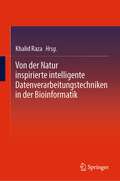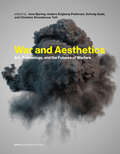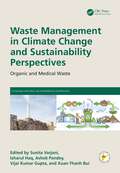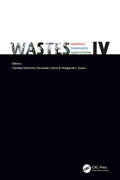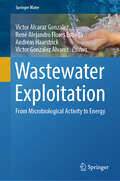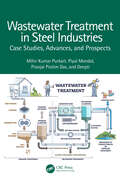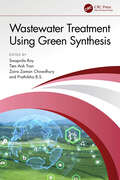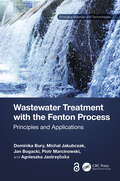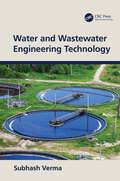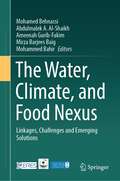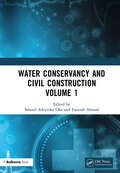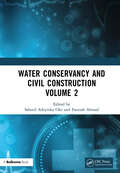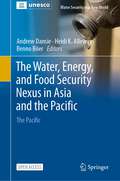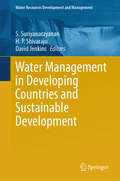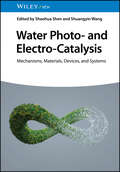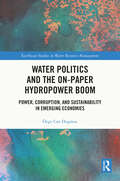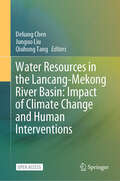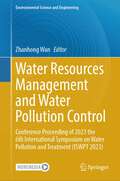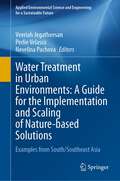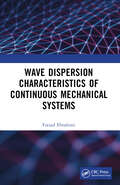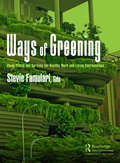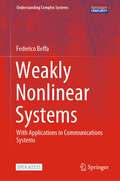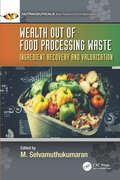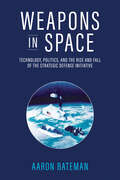- Table View
- List View
Von der Natur inspirierte intelligente Datenverarbeitungstechniken in der Bioinformatik
by Khalid RazaDieses Buch umfasst und beschäftigt sich mit den jüngsten Fortschritten und modernsten Anwendungen von naturinspirierten Computertechniken (NIC) im Bereich der Bioinformatik und der Computerbiologie, die die medizinischen Wissenschaften bei verschiedenen klinischen Anwendungen unterstützen können. Dieser Sammelband befasst sich mit den grundlegenden Anwendungen, dem Umfang und den Zukunftsperspektiven von NIC-Techniken in der Bioinformatik, einschließlich der Erstellung von Genomprofilen, der Klassifizierung von Genexpressionsdaten, der DNA-Berechnung, der System- und Netzwerkbiologie, der Lösung von Komplikationen bei personalisierten Therapien, der antimikrobiellen Resistenz bei bakteriellen Krankheitserregern und der computergestützten Entwicklung von Arzneimitteln, deren Entdeckung und Therapie. Darüber hinaus wird die Rolle von NIC-Techniken bei verschiedenen Krankheiten und Störungen behandelt, einschließlich Krebserkennung und -diagnose, Brustkrebs, Erkennung von Lungenkrankheiten, Krankheits-Biomarkern und Identifizierung potenzieller Therapeutika.
War and Aesthetics: Art, Technology, and the Futures of Warfare (Prisms: Humanities and War #1)
by Jens Bjering, Anders Engberg-Pedersen, Solveig Gade, and Christine Strandmose ToftA provocative edited collection that takes an original approach toward the black box of military technology, surveillance, and AI—and reveals the aesthetic dimension of warfare.War and Aesthetics gathers leading artists, political scientists, and scholars to outline the aesthetic dimension of warfare and offer a novel perspective on its contemporary character and the construction of its potential futures. Edited by a team of four scholars, Jens Bjering, Anders Engberg-Pedersen, Solveig Gade, and Christine Strandmose Toft, this timely volume examines warfare through the lens of aesthetics, arguing that the aesthetic configurations of perception, technology, and time are central to the artistic engagement with warfare, just as they are key to military AI, weaponry, and satellite surveillance.People mostly think of war as the violent manifestation of a political rationality. But when war is viewed through the lens of aesthesis—meaning perception and sensibility—military technology becomes an applied science of sensory cognition. An outgrowth of three war seminars that took place in Copenhagen between 2018 and 2021, War and Aesthetics engages in three main areas of inquiry—the rethinking of aesthetics in the field of art and in the military sphere; the exploration of techno-aesthetics and the wider political and theoretical implications of war technology; and finally, the analysis of future temporalities that these technologies produce. The editors gather various traditions and perspectives ranging from literature to media studies to international relations, creating a unique historical and scientific approach that broadly traces the entanglement of war and aesthetics across the arts, social sciences, and humanities from ancient times to the present. As international conflict looms between superpowers, War and Aesthetics presents new and illuminating ways to think about future conflict in a world where violence is only ever a few steps away.ContributorsLouise Amoore, Ryan Bishop, Jens Bjering, James Der Derian, Anthony Downey, Anders Engberg-Pedersen, Solveig Gade, Mark B. Hansen, Caroline Holmqvist, Vivienne Jabri, Caren Kaplan, Phil Klay, Kate McLoughlin, Elaine Scarry, Christine Strandmose Toft, Joseph Vogl, Arkadi Zaides
Waste Management in Climate Change and Sustainability Perspectives: Organic and Medical Waste (Sustainable Industrial and Environmental Bioprocesses)
by Sunita Varjani Izharul Haq Ashok Pandey Vijai Kumar Gupta Xuan-Thanh BuiThis handbook discusses the relationships and effects of climate change on waste treatment and its sustainable management. The waste management sector is in a unique position to transition from a minor source of global greenhouse gas (GHG) emissions to a major contributor to reducing GHG emissions. This book compiles the potential impacts and benefits of various waste management systems in terms of climate impact. It investigates the global climate impact of municipal solid waste, commercial and industrial waste, agricultural waste, and hazardous waste management systems.Key features: Reviews advanced and innovative processes for sustainable waste management Covers green waste treatment technologies using microbes, green soldier flies, earthworms and bacteriophages Discusses the negative and positive effects of waste treatment and disposal Provides relevant case studies from different regions of the world Examines the role of climate change on emerging pollutants The book is meant for researchers and professionals in environmental sciences, chemical and biochemical engineering.
WASTES: Selected Papers from the 6th International Conference Wastes 2023, 6 – 8 September 2023, Coimbra, Portugal (Wastes: Solutions, Treatments and Opportunities)
by Cândida VilarinhoWASTES: Solutions, Treatments and Opportunities IV contains selected papers presented at the 6th edition of the International Conference Wastes: Solutions, Treatments and Opportunities, that took place on 6-8 September 2023, in Coimbra, Portugal. The Wastes conference, which takes place biennially, is a prime forum for sharing innovations, technological developments and sustainable solutions for waste management and recycling sectors worldwide, with the participation of experts from academia and industry. The papers included in this book cover a wide range of topics, including: - Management of waste streams - Environmental, economic and social aspects in waste management - Logistics, policies, regulatory constraints and markets in waste management - Waste-to-energy technologies - Life cycle assessment and carbon footprint - Biological treatment techniques - Waste treatment and valorization technologies - Circular economy and industrial symbioses - Smart technologies and digital tools in waste management - Recycling of wastes and resources recovery - Wastes refineries - Food waste management and bioeconomy - Plastic waste impacts, management strategies and solutions - Wastes as critical raw materials resources WASTES: Solutions, Treatments and Opportunities IV is aimed at academics and professionals involved in waste management and recycling sectors globally.
Wastewater Engineering: Issues, Trends, and Solutions
by Ashok Kumar Gupta Venkatesh Uddameri Abhradeep Majumder Shripad K. NimbhorkarWastewater Engineering: Issues, Trends, and Solutions explains current treatment scenarios of wastewater in different countries across the globe, the characteristics of wastewater, and rules and regulations associated with the treatment and disposal/reuse of wastewater. It covers the design and theory involving laying of sewerage network and different conventional and advanced treatment technologies employed to treat domestic wastewater. It overviews different types of emerging contaminants and their properties, ecological impacts, detection/quantification, treatment technologies, and circular economy. Features: Gives an overview of current wastewater treatment scenarios across the world. Provides insights into emerging contaminants sources, procedure to sample, available methods for analyses, and possible treatments. Reviews existing rules and regulations on wastewater engineering and standards for wastewater disposal or reuse. Includes how to use wastewater as a resource in the context of circular economy. Describes fundamentals of wastewater conveyance and treatment. The book is aimed at graduate students and researchers in wastewater treatment, water, and environmental engineering.
Wastewater Exploitation: From Microbiological Activity to Energy (Springer Water)
by Andreas Haarstrick Victor Alcaraz Gonzalez René Alejandro Flores Estrella Victor Gonzalez AlvarezWith all the current efforts to use non-fossil sources as a starting point for future energy solutions, consideration is also being given to using microbial activities as a direct or indirect source of energy production. This ranges from the use of algae as biomass or as H2 producers, anaerobic microorganisms to produce methane, hydrogen, and even electricity directly. This book deals with both theoretical and technical possibilities of using anaerobic microorganisms in combination with wastewater as a substrate source to produce biofuels and bioenergy in the form of biomass, CH4 and H2 as well as the corresponding power densities and electricity quantities in economically justifiable processes. Unique process facilities are widely addressed; however, special interest is also placed in biorefinery and circular economy related concepts. The theoretical background as well as application examples are presented.
Wastewater Treatment in Steel Industries: Case Studies, Advances, and Prospects
by Mihir Kumar Purkait Piyal Mondal Pranjal Pratim Das DeeptiTreatment of toxic wastewater generated from different unit operations of the steel industry is a matter of extensive research. The most important is the utilization of different treatment techniques, especially ozonation, electrocoagulation, precipitation, and various hybrid methods for the remediation of toxic pollutants. This book covers case studies of various treatment techniques utilized for the remediation of different steel industry unit operation wastewater. The book is aimed at researchers and graduate students in wastewater treatment and chemical engineering. Features: Focuses on case studies of steel industry-generated wastewater treatment. Discusses different unit operations of the steel industry along with wastewater generation. Provides insights for the remediation of toxic industrial wastewater by different advanced treatment techniques. Considers the environmental impacts of the generated steel plant wastewater. Includes focused knowledge and future insights on wastewater treatment.
Wastewater Treatment Using Green Synthesis
by Swapnila Roy Tien Anh Tran Zaira Zaman Chowdhury Prathibha B. S.Focuses on the implementation of effective wastewater treatment with orientation towards biological processes Covers both biological and physico-chemical waste and wastewater treatment processes, focusing on emerging techniques Reviews computational method approaches, the application of TiO2-doped biopolymers, iron nanoparticles and the use of molecular techniques for wastewater treatment Illustrates molecular docking, molecular dynamics simulation, homology modeling, and biodegradation pathways prediction Includes dedicated chapters on biological wastewater treatment
Wastewater Treatment with the Fenton Process: Principles and Applications (Emerging Materials and Technologies)
by Dominika Bury Michał Jakubczak Jan Bogacki Piotr Marcinowski Agnieszka JastrzębskaThe presence of refractory organic compounds in wastewater is a global problem. Advanced oxidation processes, in general, and the Fenton oxidation process are alternative technologies for wastewater and water treatment. This book gives an overview of Fenton process principles, explains the main factors influencing this technology, includes applications, kinetic and thermodynamic calculations and presents a strong overview on the heterogeneous catalytic approach. It demonstrates that the iron-based heterogeneous Fenton process, including nanoparticles, a new complex solution, is highly efficient, environmentally friendly and can be suitable for wastewater treatment and industrial wastewater. FEATURES Describes in detail the heterogeneous Fenton process and process applications Analyzes the advantages and disadvantages of different catalysts available and their suitability to specific processes Provides economic analysis of the Fenton process in a ready-to-use package for industrial practitioners for adaptation into already existing industrially viable technologies Promotes a modern solution to the problem of degradation of hazardous compounds through ecological and environmentally friendly processes and the use of a catalyst that can be recycled Explains highly complex data in an understandable and reader-friendly way Intended for professionals, researchers, upper-level undergraduate and graduate students in environmental engineering, materials science, chemistry, and those who work in wastewater management.
Water and Wastewater Engineering Technology
by Subhash VermaWater and Wastewater Engineering Technology presents the basic concepts and applications of water and wastewater engineering technology. It is primarily designed for students pursuing programs in civil, water resources, and environmental engineering, and presents the fundamentals of water and wastewater technology, hydraulics, chemistry, and biology. The book examines the urban water cycle in two main categories, water treatment and distribution, and wastewater collection and treatment. The material lays the foundation for typical one-semester courses in water engineering and also serves as a valuable resource to professionals operating and managing water and wastewater treatment plants. The chapters in this book are standalone, offering the flexibility to choose combinations of topics to suit the requirements of a given course or professional application. Features: • Contains example problems and diagrams throughout to illustrate and clarify important topics. • Problems both in SI and USC system of units. • The procedure of unit cancellation followed in all solutions to the problems. • Design applications and operation of water and wastewater system emphasized. • Includes numerous practice problems with answers, and discussion questions in each chapter cover a range of engineering interventions to help conserve water resources and preserve water quality.
The Water, Climate, and Food Nexus: Linkages, Challenges and Emerging Solutions
by Mohamed Behnassi Abdulmalek A. Al-Shaikh Ameenah Gurib-Fakim Mirza Barjees Baig Mohammed BahirThis contributed book, as a part of a series of CERES publications, provides a multi-regional and cross-sectoral analysis of the interlinkages, challenges, and emerging responses in the areas of water security, climate change, and food systems, especially in a context marked by severe implications of the COVID-19 pandemic, increased climate vulnerability of many regions already water stressed, and an ambitious global action aiming at curbing climate change and restoring ecosystem. In the first set of chapters, the water, food, and environmental/climate security nexus is explored theoretically and by reference to empirical research covering many regions and sectors. In another set of chapters, the impacts of climate change on water resources and water-stressed regions are identified along with their implications for food systems and security. Other chapters of the volume identify the emerging solutions to the nexus challenges, mainly adaptation and mitigation options, governance and management approaches, technological and economic solutions, innovative farming and water management practices, etc. Most chapters scheduled for publication address timely and future-oriented topics, are based on empirical research particularly done in water-constrained and climate vulnerable countries from Asia, Africa, and the MENA region, and provide policy-oriented inputs and recommendations to guide change processes at multiple scales.
Water Conservancy and Civil Construction Volume 1: Proceedings of the 4th International Conference on Hydraulic, Civil and Construction Engineering (HCCE 2022), Harbin, China, 16-18 December 2022
by Saheed Adeyinka Oke Fauziah AhmadWater Conservancy and Civil Construction gathers the most cutting-edge research on: Water Conservancy Projects Civil Engineering Construction Technology and Process The book is aimed at academics and engineers in water and civil engineering.
Water Conservancy and Civil Construction Volume 2: Proceedings of the 4th International Conference on Hydraulic, Civil and Construction Engineering (HCCE 2022), Harbin, China, 16-18 December 2022
by Saheed Adeyinka Oke Fauziah AhmadWater Conservancy and Civil Construction gathers the most cutting-edge research on: Water Conservancy Projects Civil Engineering Construction Technology and Process The book is aimed at academics and engineers in water and civil engineering.
The Water, Energy, and Food Security Nexus in Asia and the Pacific: The Pacific (Water Security in a New World)
by Andrew Dansie Heidi K. Alleway Benno BöerThis open access book considers the water, energy, food (WEF) nexus in the Pacific region. The region comprises seventeen sovereign countries and seven territories spread across the Pacific Ocean, a blue expanse that covers a fifth of the world’s surface area but contains only 0.5% of the population—or 44.5 million people. The uniqueness of the Pacific and the need for a Pasifika-led approach to sustainability across environmental, societal and economical spheres requires this blue continent to be considered in a separate volume under the ‘Water Security in a New World’ series.This Pacific volume is focussed on water, energy and food security in Pacific Island Countries and Territories (PICTs) and the challenges produced by the impacts of anthropogenic climate change and human population pressures. The diversity of culture, traditional knowledge and ways of life across the Pacific are united by similar geographies and opportunities to apply a ‘Pacific specific’ WEF nexus approach; a coordinated approach to manage water, energy and food that is centred on active decision making across the three sectors to increase the security of each. Importantly, a WEF nexus approach builds on national and international efforts to date in the Pacific which include Integrated Water Resource Management, Ridge to Reef, Source to Sea, UNESCO Biosphere Reserves, Integrated Coastal Zone Management and other similar approaches.In this book, contributions by authors from governments, regional bodies, multilateral agencies, and academia describe water security and its intersectionality with both the energy and food sectors, highlighting the significance of both land and marine food systems and connectivity between water and energy in a Pacific-focussed context. It is demonstrated that these systems cannot be separated from the challenges associated with healthy environments and functioning ecological services, transport, and waste that are unique to this vast archipelagic region. To achieve meaningful change, it is essential that solutions are cognizant of the world’s colonial past and the global inequalities that persist today. The path forward for water and food systems is one that is Pasifika-led and builds on traditional knowledge and local capacity. National energy demands must consider the future with solutions comprising both WEF-integrated approaches and new energy technologies to hasten the transition away from fossil fuels. Globally, major greenhouse gas emitters both past and present need to step up for the environmental and economic benefit of all by rapidly reducing greenhouse gas emissions and supporting Pasifika leadership on highly ambitious net zero goals.This book is a highly recommended source of information and inspiration for policy makers, decision makers, research communities and practitioners dealing with any aspect of water, energy, or food security in the Pacific.
Water Management in Developing Countries and Sustainable Development (Water Resources Development and Management)
by David Jenkins S. Suriyanarayanan H. P. ShivarajuThis book provides information on sustainable water resource management strategies that present innovative ways to conserve both quality and quantity of water in developing countries. The book comprises of 24 chapters contributed by authors from 14 countries, namely, Cameroon, China, Cyprus, India, Indonesia, Italy, Namibia, the Netherlands, Norway, Portugal, South Africa, the United Kingdom, the United States of America and Zimbabwe. This book will be of great interest to researchers, practitioners, water resource managers, policy and decision makers, international institutions, governmental and non-governmental organizations, educators, as well as students.
Water Photo- and Electro-Catalysis: Mechanisms, Materials, Devices, and Systems
by Shaohua Shen Shuangyin WangWater Photo- and Electro-Catalysis Introduce yourself to the cutting-edge processes of water photo- and electro-catalysis with this important guide Photocatalysis and electrocatalysis reactions involving water are becoming an increasingly important component of energy and sustainability research. Water electrocatalysis and photo-electrocatalysis promise to have a significant impact on human energy production and its by-products, and to play a substantial role in solutions to global energy and environmental crises. Familiarity with these processes will be critical for sustainable energy production in the coming years. Water Photo- and Electro-Catalysis provides a detailed and readable introduction to these processes and their attendant technologies. It covers mechanisms, materials, and devices that catalyze water-based energy conversion, as well as introducing the theoretical principles that are driving the development of new technologies in this area. The result is an essential book for researchers and materials scientists in a range of fields. Water Photo- and Electro-Catalysis readers will also find: An editorial team with decades of combined experience in energy and materials science researchDetailed treatment of electrocatalysis processes for hydrogen evolution (HER), oxygen/hydrogen peroxide evolution (OER/HPER), and moreAnalysis of mechanisms including heterogenous vs. homogenous photocatalysis, electrodes-based photo-electrocatalysis, and photovoltaic-electrocatalysis Water Photo- and Electro-Catalysis is a valuable reference for catalytic chemists, materials scientists, energy chemists, and all research and industry professionals in photo(electro)catalysis and sustainable energy fields.
Water Politics and the On-Paper Hydropower Boom: Power, Corruption, and Sustainability in Emerging Economies (Earthscan Studies in Water Resource Management)
by Özge Can DogmusThis book examines how the on-paper hydropower boom impacts the safe and fair access to water and energy in emerging economies.The global hydropower boom is largely made up of small hydropower plants located in emerging economies, but a lack of funding, over-ambitious planning, and corruption have halted the production of these projects. Describing this state as the ‘on-paper’ hydropower boom, this book shifts attention to the hydrosocial problems arising from hydropower projects that remain on paper. It examines how these proposed but unbuilt projects can lead to disruptions in the control and governance of water resources and increase the international dependence of emerging countries due to deep problems in their sustainable development planning and how all this can affect both ecosystems and the communities that depend on them. In doing so, it critically examines the dominant discourses on energy security and sustainable development, emphasises the extent to which the effects of global imperialism are at play, and examines the effects of international power relations in the hydrosocial context and their implications for perpetuating international relations of dependency. Further, this book provides a unique perspective on the global hydropower boom by highlighting that although the global hydropower boom largely remains on paper, it can still have a significant impact on human–water systems. Contributing to the debate on hydrosocial relationships, each chapter offers an insightful examination of the social, cultural, and political interactions that humans have with water and uses these insights to provide a nuanced understanding of the challenges and issues associated with on-paper plans.This book will be of great interest to students and scholars of water politics, water governance, political ecology, corruption and environmental economics, as well as sustainable development policymakers.
Water Resources in the Lancang-Mekong River Basin: Impact of Climate Change and Human Interventions
by Qiuhong Tang Deliang Chen Junguo LiuThis open access book provides a comprehensive, up-to-date picture of the current state of knowledge covering climate change, surface water change, arsenic pollution, water utilization, water-food-energy nexus, water related hazards, water management, and water governance in the Lancang-Mekong River Basin. Considering the widely concerned fact that the climate change and human intervention induced impacts on water will bring unprecedented threats to human societies and ecosystems, the book intends to support UN’s sustainable development goals through sustainable use of water by providing the most accurate and updated information on climate and water changes in a consistent way. Underlying all aspects of the book is a strong commitment to assessing the science comprehensively, without bias and in a way that is relevant to policy but not policy prescriptive. It can provide implications to support decision-makers and stakeholders for integrated water resources management and sustainable development at all levels.
Water Resources Management and Water Pollution Control: Conference Proceeding of 2023 the 6th International Symposium on Water Pollution and Treatment (ISWPT 2023) (Environmental Science and Engineering)
by Zhanhong WanThis book features select peer-reviewed proceedings from the 6th International Symposium on Water Pollution and Treatment (ISWPT 2023). It comprises articles written by researchers, practitioners, policymakers and entrepreneurs that examine recent advancements in water pollution and treatment. The book covers a range of topics, including the impact of climate change on water pollution and technologies for reducing greenhouse emissions in water and wastewater treatment. Additionally, it explores water resources planning and management, water quality protection and technologies and processes that control water pollution. This book is useful for beginners, researchers and professionals working in the area of water pollution management, policy and governance.
Water Treatment in Urban Environments: Examples from South/Southeast Asia (Applied Environmental Science and Engineering for a Sustainable Future)
by Veeriah Jegatheesan Perlie Velasco Nevelina PachovaThe value of implementing nature-based solutions (NbS) for water treatment in urban environments is increasingly recognized due to the multiple ecosystem services and societal benefits they provide. The successful implementation of NbS for urban water treatment, however, depends on a range of diverse technical and societal factors that need to be taken into account. Those vary by the type of NbS implemented, the societal challenges the NbS are designed to address and the local ecological, socio-economic and political context, in which the solutions are implemented. This book provides a collection of guidelines for the implementation of three types of NbS for water treatment in urban environments across cities in South/Southeast Asia, namely constructed wetlands, green roofs and floating treatment wetlands. The guides were developed based on existing experiences with the establishment, operation, and maintenance of those three types of NbS in three different countriesin South/Southeast Asia and the lessons learnt from their implementation. They provide detailed outlines of suggested steps for ensuring successful implementation in the respective local contexts. Those include overall planning schemes, surveys for socio-economic evaluations, suggested methods for construction and associated costs, required maintenance as well as a range of operational monitoring parameters. It also includes examples of approaches for the scaling of the three types of NbS discussed in the book in their respective local contexts. This book is expected to benefit local government units and contractors, and other stakeholders involved in NbS implementation and up-scaling, as well as researchers and postgraduate students who plan to conduct pilot-scale studies on NbS.
Wave Dispersion Characteristics of Continuous Mechanical Systems
by Farzad EbrahimiWave Dispersion Characteristics of Continuous Mechanical Systems provides a mechanical engineering-based analysis of wave dispersion response in various structures created from different materials. Looking at materials including strengthened nanocomposites, functionally graded materials, metal foams, and anisotropic materials, it uses analytical solution methods to solve typical problems in the framework of a micromechanics approach. Nanocomposites are a novel type of composite materials, fabricated by dispersing nanosized reinforcements in a matrix to combine the material properties of the matrix with the improved properties of nanosized elements. This book enables readers to learn about the theory and practical applications of this rapidly evolving field. Practically minded, the book investigates the impact of employing various nanofillers and demonstrates how this augments stiffness within the nanocomposite. Topics covered include agglomeration and waviness of nanofillers, porosity, elastic mediums, fluid flow, and the impact of the thermal environment on a propagated wave. Using mathematical formulations to solve wave dispersion characteristics of structures including beams, plates, and shells, the book obtains equations of structures using first- and higher-order shear deformation theories. This book will be of interest to professional engineers working in material and mechanical engineering, nanocomposites, nanofillers, and micromechanics. It will also be of interest to students in these fields.
Ways of Greening: Using Plants and Gardens for Healthy Work and Living Surroundings
by Stevie FamulariThis book focuses on rethinking working and living spaces and understanding how "greening" can make them healthier and their occupants happier. It teaches how to see unique ideas for spaces and some of the materials needed to create the designs. Inspired by a study that states that 8% of a space needs to have plants in order to positively affect the air quality of the space, this book explores what that minimum would look like in spaces and how it can be done to existing spaces as well as to new site designs, greening both interiors and exteriors. Using the mathematical amount of 10% per square foot, the illustrations start at that quantity of greening and show how it can look. The sites selected are both public and private sites, as well as interior and exterior. As there are more modalities, needs, and locations where people now work, making sure that multiple types of spaces are designed for people’s success is more relevant than ever. This includes designs for more traditional offices, open-air offices, commercial spaces, homes, studios, and more. Ways of Greening: using Plans and Gardens for Healthy Work and Living Surroundings gives readers a way to not only understand greening but to understand how to see greening applied to their place. The two basic ways to see the spaces selected are existing spaces to which greening design is applied afterward and upcoming spaces in which greening design can be built directly into the space. The first type of retrofitting greening into existing spaces can also be combined with the second type of space (new designs). There are examples of both types throughout the book. Essentially, this book addresses ways in which business owners, residents, developers, architects, agencies, and others can integrate greening to improve the air quality and the quality of life with a green solution.
Weakly Nonlinear Systems: With Applications in Communications Systems (Understanding Complex Systems)
by Federico BeffaThe open access book covers a large class of nonlinear systems with many practical engineering applications. The approach is based on the extension of linear systems theory using the Volterra series. In contrast to the few existing treatments, our approach highlights the algebraic structure underlying such systems and is based on Schwartz’s distributions (rather than functions). The use of distributions leads naturally to the convolution algebras of linear time-invariant systems and the ones suitable for weakly nonlinear systems emerge as simple extensions to higher order distributions, without having to resort to ad hoc operators. The result is a much-simplified notation, free of multiple integrals, a conceptual simplification, and the ability to solve the associated nonlinear differential equations in a purely algebraic way. The representation based on distributions not only becomes manifestly power series alike, but it includes power series as the description of the subclass of memory-less, time-invariant, weakly nonlinear systems. With this connection, many results from the theory of power series can be extended to the larger class of weakly nonlinear systems with memory. As a specific application, the theory is specialised to weakly nonlinear electric networks. The authors show how they can be described by a set of linear equivalent circuits which can be manipulated in the usual way. The authors include many real-world examples that occur in the design of RF and mmW analogue integrated circuits for telecommunications. The examples show how the theory can elucidate many nonlinear phenomena and suggest solutions that an approach entirely based on numerical simulations can hardly suggest. The theory is extended to weakly nonlinear time-varying systems, and the authors show examples of how time-varying electric networks allow implementing functions unfeasible with time-invariant ones. The book is primarily intended for engineering students in upper semesters and in particular for electrical engineers. Practising engineers wanting to deepen their understanding of nonlinear systems should also find it useful. The book also serves as an introduction to distributions for undergraduate students of mathematics.
Wealth out of Food Processing Waste: Ingredient Recovery and Valorization (Nutraceuticals)
by M. SelvamuthukumaranHigh amounts of waste are generated daily in various food processing industries inclusing seed, pomace, pit, peel, germ, husk, broken pulses, sludge, skin, bones, blood, feathers, wash water, and spent residue, among others. Several tons of generated waste can be effectively used to manufacture or recover such value-added by-products as fibers, antioxidants, proteins, vitamins and minerals, biofilms, fertilizers, and animal feed. While food processing- generated waste may lead to health and environmental hazards, it is critical to identify proper protocols to recover valuable ingredients from waste, thereby creating wealth in the society.Wealth out of Food Processing Waste identifies and describes the proper protocols to recover valuable ingredients from waste, thereby creating wealth in society. The effective utilization of waste can generate income for the entrepreneur, lead to more employment for society, enhance fertility of soil, reduce environmental pollution, conserve resources, and help augment national economies to a greater extent.Key Features: Provides in-depth knowledge about conversion of waste derived from various food processing industries into various value-added products Highlights the extraction of antioxidants and functional food ingredients from industrial food waste Presents current and emerging trends using biotechnological approaches for conversion of waste into various value-added products This book provides food industry personnel, scientists, food engineers, biotechnologists, research scholars, and students with strategies for effective utilization of waste from various food processing industries.
Weapons in Space: Technology, Politics, and the Rise and Fall of the Strategic Defense Initiative
by Aaron BatemanA new and provocative take on the formerly classified history of accelerating superpower military competition in space in the late Cold War and beyond.In March 1983, President Ronald Reagan shocked the world when he established the Strategic Defense Initiative (SDI), derisively known as &“Star Wars,&” a space-based missile defense program that aimed to protect the US from nuclear attack. In Weapons in Space, Aaron Bateman draws from recently declassified American, European, and Soviet documents to give an insightful account of SDI, situating it within a new phase in the militarization of space after the superpower détente fell apart in the 1970s. In doing so, Bateman reveals the largely secret role of military space technologies in late–Cold War US defense strategy and foreign relations.In contrast to existing narratives, Weapons in Space shows how tension over the role of military space technologies in American statecraft was a central source of SDI&’s controversy, even more so than questions of technical feasibility. By detailing the participation of Western European countries in SDI research and development, Bateman reframes space militarization in the 1970s and 1980s as an international phenomenon. He further reveals that even though SDI did not come to fruition, it obstructed diplomatic efforts to create new arms control limits in space. Consequently, Weapons in Space carries the legacy of SDI into the post–Cold War era and shows how this controversial program continues to shape the global discourse about instability in space—and the growing anxieties about a twenty-first-century space arms race.
